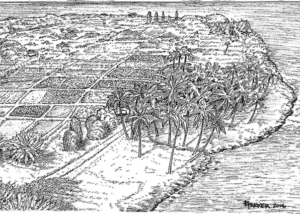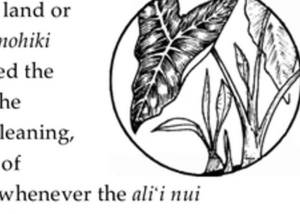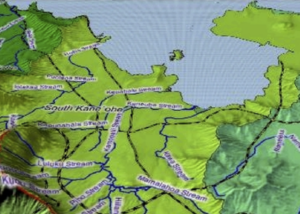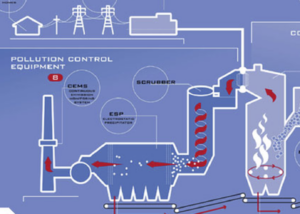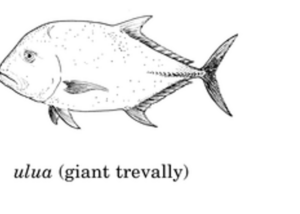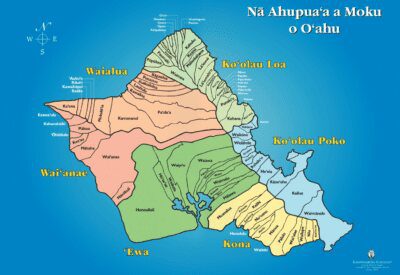Aloha ‘Āina Curriculum, Pacific American Foundation
We shape the future, while preserving our heritage.
‘Āina is that which nourishes. It encompasses land, ocean, heavens, land-based water systems, plants and animals.
Aloha ‘Āina is a way of life inherent in Hawaiian practices.
Our multidisciplinary journey will take students through readings, reflections in writing, interviews with kūpuna (elders), creative collaborative projects, problem-solving in math and science, and investigations in their ahupua‘a. Teacher guides, instructional notes, student activity logs, worksheets, pre-post test, and five part inspirational video provide culturally relevant materials for teaching about ahupua‘a land-management systems, and inspiring youth to be future stewards and scientists who will care for the land and preserve traditions.
Introductory Aloha ‘Āina video sets up the curriculum, letting students take a trip with us to discover the gifts that the ʻāina provides in their ahupuaʻa.
It’s a journey of discovery that includes moʻolelo, ʻoli, wonderful music, beautiful places and meaningful relationships between people and the place where they live!
©2007, 2024 All Rights Reserved, The Pacific American Foundation
Educational Use Only, under the limited circumstances of the Fair Use Doctrine.
As a Teacher, Parent or Student, you may print a copy of sections, within reason, of our educational materials for non-commercial use only. Materials may also be purchased, and donations are accepted by our nonprofit organization, which is another way to support The Pacific American Foundation so that we can continue to produce educational materials and provide services to the community.
Students will be inspired to:
Embrace aloha ‘āina as a way of life
Learn science, math, social studies, and language arts
Care for resources within students’ ahupua‘a
We’ll visit:
Kaua‘i: Waipā
O‘ahu: Kāne‘ohe, Kalihi, Wai‘anae, Waikīkī
Moloka‘i: islandwide
Maui: Kīhei and Waihe‘e, Hāna
Hawai‘i: Hilo, Kona
Instructional Activities
On each grade level, four to six lessons are designed to be taught sequentially. Teachers are provided background information, rubrics for individual benchmarks, lists of materials, student worksheets including Student readings, Maps, Learning Log/Journal, Activity cards and more.
Grades K–2 units were developed in collaboration with Chaminade University of Honolulu.
Gardening units for grades 7-8 were created in collaboration with Waipā Foundation in Hanalei, Kaua‘i.
Project Aloha ‘Āina was produced in cooperation with the Hawai‘i State Department of Education.
The teacher guides were developed with grants by the Native Hawaiian Education Program, U.S. Department of Education.
Teachers will notice that the older units were written to meet the benchmarks of the Hawai‘i Content and Performance Standards, (HCPS III), the General Learner Objectives (GLOs), and the cultural guidelines for healthy learning environments of Nā Honua Mauli Ola (NHMO).
Na Oli (Chants)
E Hō Mai
Composed by: Edith Kekuhikuhipu’uoneo’naali’iokohal
E hō mai ka ‘ike mai luna mai e
O nā mea huna no`eau no nā mele e
E hō mai
E hō mai
E hō mai
Grant us the knowledge from above
Concerning the hidden wisdom of songs,
Grant,
Grant,
Grant us these things
Kumu hula master and Hawaiian cultural and language expert, Edith K. Kanāka`ole (affectionately known as Aunty Edith), composed this oli (chant) for her hula troupe, Hālau O Kekuhi. The chant was originally performed by students at the beginning of class to request knowledge and wisdom from the ancestral deities to accomplish the task at hand.
Today, this oli is commonly used at the start of an event or small gathering to focus a group’s energies and ultimately carry out the kuleana (responsibility) they have undertaken. It is recommended that haumāna (students) use this chant to help them seek knowledge and clear their minds of any negativity.
E Ulu
From Nathaniel H. Emerson
Unwritten Literature of Hawaii: The Sacred Songs of the Hula (1999)
E ulu, e ulu
Kini o ke Akua
Ulu Kāne me Kanaloa
Ulu `ohi`a lau koa me ka `ie`ie
A`e mai i noho i kou kuahu
Eia ka wai, he wai e ola
E ola no e!
Grow, grow
In the multitude of God
Grow with respect to the forest and sea
Grow with 0hi’a, koa and ‘ie’ie
Inhabit your place O God
Here is the water, the water of life
Life forever!
Kumu hula master and Hawaiian cultural and language expert, John Keola Lake, taught this oli to Kumu Hula Ka’anohi Aipa. In her hālau it is often used a a gathering chant when haumāna enter the forest to collect greenery for costumes or ho’okupu (offerings). It may also be used when entering the forest for inspiration or guidance.
Hiki mai ka Lā
From Pele and Hiʻiaka – A Myth from Hawaiʻi by Nathaniel B. Emerson (1915)
Hiki mai, hiki mai ka lā
Aloha wale, ka lā e kau nei
Aia malalo o Kawaihoa
A ka lalo o Kauaʻi
O Lehua
Here it comes, here comes the Sun
How I love the Sun in the sky
There below is Kawaihoa
On the incline of Kauaʻi
Is Lehua
BACKGROUND
Peleʻs sister Kapoulakinau danced this hula on the island of Niʻihau. It is considered one of the earliest of hula, a hula kiʻi.
This oli was shared with the Windward Ahupuaʻa Kūpuna by Anakala Kimo Awai of Hilo along with the Hilo districtʻs kūpuna. He also taught its motions. It is both a chant of welcome to the morning Sun in the sky as well as a request for inspiration from Ke Akua, the creation, or our ancestors.
Ola i ka Hā
Composed by: Frank Kawaikapuokalani Hewett
Ola i ka hā
Ola i ka wai
Ola i ka `I
Hāwai`ī, Hāwai`ī, Hāwai`ī
Wākea ka lani
Papa ka hōnua
No ka lunā, ko lunā
No ka lalo, ko lalo
O ka pono no ia e
E ola kākou a mau loa e
There is life in the breath (hā – Hāloa/kalo)
There is life in the waters (Kāneikawaiola – god of creation)
There is life in the supreme (Kumulipo chant of
Kalaninui`īamamao)
Hā – wai – `ī (reflecting the genealogies of creation of
Hāwai`i, God, the environment and humankind)
Wākea of the heavens
Papa of the earth
For up belonging up
For down belonging down
It is the “Natural Order”, May we live forever
Ola i ka hā
The first line is a reflection of the legend of the origin of the kalo, the child of Wākea and Ho`ohōkükalani who soon after birth expired. This child was buried near their home and from his body grew forth the kalo plant. A second son was born to Wākea and Ho`ohōkükalani and he became the father of the human race. Like his elder brother, he was also named Hāloa with the epithet nakalaukapalili added to his name. The first birth of the first Hāloa established the tradition of the senior line in the Hawaiian tradition, and the birth of the second Hāloa established the tradition of the junior line subservient to the senior line, humankind as custodians to the gods who manifest in nature/environment. The word hā used in the first line is a reflection of the names Hāloa and Hāloanakalaukapalili.
Ola i ka wai
The second line is a reflection of the god, Kāne, the god of creation. Kāne has many forms, which include the water, the sunlight, and the rainbow. Kāne is the giver of life and not the taker of life, therefore no human sacrifices were offered to him. He is at the zenith in the pantheon of gods and the other gods are said to be lesser manifestations of him. Kāne worship incorporated shrines with sacred upright stones where prayers and offerings were left.
In order for the kalo to grow tall and strong it needs both water and sunlight, both manifestations as mentioned earlier of the god, Kāne. An ancient proverb states, “Pü`ali`ali kalo i ka wai `ole,” without water the kalo grows misshapen or crooked. Kāne in the form of water not only provides sustenance for good healthy growth of the kalo but also provides sustenance – the same for mankind.The word “wai,” in the second line, is a reflection of the god, Kāneikawaiola – the god of the living or healing waters.
Ola i ka ‘ī
The third line is a reflection of the Kumulipo chant used as a prayer when chief Lonoikamakahiki was dedicated to the gods soon after birth. The honors of Kapu, Wela, Hoano and Moe were conferred to him by his father, Keawekekahiali`iokamoku, King of Hawaiʻi. After the ceremony his name was changed to Ka-`ī-`i-mamao. The third line also reflects the name of ʻīo, the tradition of one supreme deity connected to the worship of the `io (hawk) and the pueo (owl).
Hāwai`ī, Hāwai`ī, Hāwai`ī
The fourth line connects the three components, the hā, the wai and the ʻī in the name Hāwai`ī;the breath or the air that we breathe, the water that we drink and god/goddess most superior. Air and water sustain life created through the god. Aunty Emma deFries explained that island names that end with (ʻi) such as Hāwai`i, Mau`i, Moloka`i, Lāna`i and Kaua`i were so named because the ruling chiefs worshipped the supreme god, ʻIo.
`Io was referred to as `ī-o-na-lani-nui-a-mamao (the Supreme most god of the great heavens and beyond.). Aunty Emma asked to always keep this tradition close at heart.
Wākea ka lani, Papa ka hōnua, No ka luna ko luna, No kalalo ko lalo and`O ka pono no ia e
The fifth, sixth, seventh, eighth and ninth lines reflect the “natural order” of our gods, environment and people. To everything there is a natural or proper order. There is a beginning and an end, a top and a bottom, a male god and a female counterpart. There is harmony, balance and unity. The gods are at the top of the triad followed by the environment and then humankind. The same order is reflected in the social structure as established in the kapu system, ali`i, kahuna, maka`āinaaā and kauwā along with terms and roles within the `ohana such as küpuna, mākua, ‘ōpio, keiki and kamaiki. From the top to the bottom, all is in its proper place. This is truly our pono. Not as translated as the word, “righteousness,” but the natural order as allotted like mana by the god/goddess.
The tenth line reflects the life, health and healing, which we attribute to our gods. The kalo and the human race were born from Wākea and Ho`ohōkükalani. The life force is in the manifestations of the god Kāne, the sun, the air and the rainbow. All of this is perpetuated by the pono, the natural order, the balance and the unity.
(Mana`o from Frank Kawaikapuokalani Hewett)
Oli Ia Laka
Noho ana ke akua
i ka nāhelehele
i ʻalai ʻia e ke kīʻohuʻohu
e ka ua koko
E nā kino malu i ka lani
malu e hoe
E hoʻoulu mai ana ʻo Laka
i kona mau kahu
ʻO wau [mākou,
ʻo wau [mākou] nō, a!
The god resides
in the thick forest
that was hidden by the clinging mist
by the low-lying rainbow
O beings sheltered in the heavens
sheltered continually
Laka will confer growth on
her caretakers
Tis I [we] ’tis I [we] indeed, ah!
Oli Komo no Kawai nui
Composed by:
Kāhea
Hāʻaleʻale ka leo (o) ka ʻalae
He māpuna leo polo ʻai i ka laʻi
He pule kānaenae i Ulupō
I ulu pono la i Ulumāwao
Kakali ka neke i ka nihi (i)
Ka niʻo o ka wahinewai
Ke nihi ka hele nei, e!
Ke nihi ka hele nei, e!
Pane
Māwehe ʻia ka neki i ka wai
E hōʻike i ka wai ʻānapanapa
Hōʻike pū nō ka manaʻo pono
E mai, hele mai, i [Nā Pōhaku] E mai, hele mai, eia nō mākou nei
(Greeting)
Full is the voice of the ʻalae
A voice of invitation in the calm
A chant of request to Ulupō
That true inspiration reaches Ulumāwao
The neke ferns await at the border
At the entrance of the woman-water
(We) proceed with due care now!
(We) proceed with due care now!
(Reply)
The neki rushes part at the water
Reveal the shimmering waters
Revealed along with your righteous intent
Approach, enter, at [Nā Pōhaku] Approach, enter, here we are
NOTES:
Other famous places along Kawai Nui can be used in place of [Nā Pōhaku] as appropriate, for example, Holomakani. There is quite a bit of kaona (hidden meaning) and symbolism in this oli that bears explanation:
• ʻalae: the ʻalae is an endangered endemic waterbird of Kawai Nui and in ancient times, the ʻalae symbolized the voice of the chief whose opinion swayed the chiefly council. Some consider the voice of the ʻalae an ill omen but as a kino lau (forms taken by a supernatural body) of Hauwahine, the voice of the ʻalae is an auspicious thing at Kawai Nui!
• māpuna leo: literally translated, it means wafted voice of few words; an apt description of the voice of ʻalae! But “māpuna” also alludes to the life-giving freshwater springs that arise in Kawai Nui.
• polo ʻai: literally means to summon, to invite. It is also a veiled allusion to the famous lepo ʻai ia (edible dirt) of Kawai Nui, one of the ʻai kamahaʻo (surprising foods) of the land.
• Ulupō and Ulumawao lie before and behind you as you chant at Nā Pōhaku, and the play on ulu (growth, inspiration) is quite obvious here.
• neke: an ambiguous reference to two plants of Kawai Nui: a fern, and also a bulrush of the same name. A variant of the name is “neki.”
• niʻo: doorway or sacred threshold, but also highest point, pinnacle, as the stone of Nā Pōhaku are perched on high, overlooking the wetlands
• wahinewai: a veiled reference to Hauwahine, the moʻo-wahine at Kawai Nui
• nihi ka hele: to proceed with careful observance of kapu. Proceeding with care is part of the protocol of respect.
• ʻānapanapa: the ʻānapanapa (soap plant) is an indigenous plant that grows around Nā Pōhaku but also describes the shimmering waters of Kawai Nui.
Oli Mahalo
Composed by: Kehau Camara—
`U hola `ia ka maka loa la
Pü`ai ke aloha la
Küka`i`ia ka Hāloa la
Pā wehi mai nā lehua
Mai ka ho`oku`i a ka hālāwai la
Mahalo, e nā akua
Mahalo, e nā küpuna la ea
Mahalo, me ke aloha la
Mahalo, me ke aloha la
To spread forth, open up the most fine quality mat
Exchange/share as potluck or aloha
Exchange as greetings (between man and wife and
descendants)
To adorn with the lehua flower
From East to West; sunrise to sunset, we are
discoverers, navigators, take care of our ʻāina
We thank our creators
We thank our ancestors
We thank you with love
We thank you with love
This oli was composed as a greeting of thanks for hospitality, love, generosity and knowledge that is given to us. It also gives thanks to the beauty of the islands and our people. Hāloa is ever-lasting breath. The kalo plant is considered our ancestor that is cherished and preserved. Makaloa is the finest mat woven. It is considered higher quality than lau hala. The message is that it’s important for us to practice being “thankful” every day
 Moʻolelo
Moʻolelo
Kalihi – Wetlands
Map: Kalihi and Kapālama Ahupuaʻa
- Kapukawaiokalihi – The Water Door of Kalihi
- A Tale of Kilohana Hill
- A Kapālama Moʻolelo – Kaulu Goes Sightseeing
Kalihi – Ahupuaʻa
Map: Kalihi and Kapālama Ahupuaʻa
- Hapuʻu and Kalaihauola
- Kapukawaiokalihi – The Destroyed Stones
- Kapukawaiokalihi – Fresh Water for the ‘Awa
- The Sacred ʻUlu Tree
Waikīkī – Wetlands
Map: Waikīkī Ahupuaʻa
Map: Mānoa and Pālolo
Waikīkī – Ahupuaʻa
Map: Waikīkī Ahupuaʻa
Map: Mānoa and Pālolo
Kawai Nui Marsh – Wetlands
Kāneʻohe – Wetlands
Map: Kāneʻohe Ahupuaʻa
Kāneʻohe – Ahupuaʻa
Map: Kāneʻohe Ahupuaʻa
Kamaile – Wetlands
Map: Mākua Kaʻānaniʻau
Kamaile – Kaʻānahiau
Map: Mākaha and Waiʻanae Kaʻānaniʻau
ʻImi ʻIke – Systems and
the Ahupuaʻa 
- Kumulipo – Translated by Queen Liliʻuokalani
- Halaʻea, The Greedy Chief
- Kapenaʻs Day
ʻImi ʻIke – Cycles and Hawaiian Traditions
Kahea Loko
Coral Reef
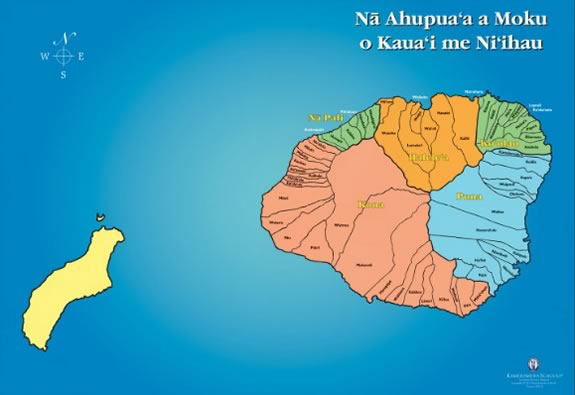 Map: Hilo Bay, Big Island of Hawaiʻi
Map: Hilo Bay, Big Island of Hawaiʻi
Map: ʻAnini Beach, Kauaʻi
Map: Māʻalaea Bay, Maui
- HILO, HAWAIʻI: The Legend of Mānaiakalani and Mokuola
- KAUAʻI: Anahola – Puka a ka Mauna
- KAUAʻI: ʻAliomanu
- MOLOKAʻI: Kuhaimoana, Shark-Guardian of Koʻolaupoko
Molokaʻi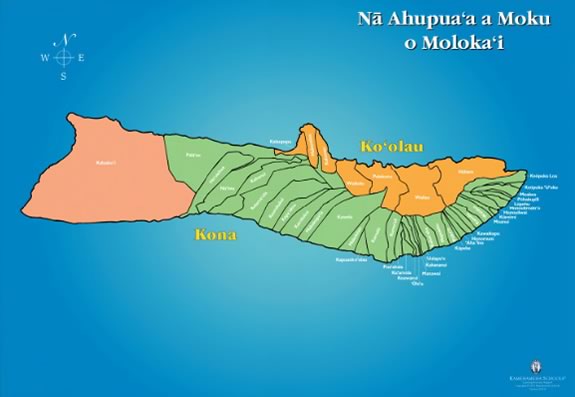
Map: Hālawa Ahupuaʻa
- WETLANDS: Kaiakea and the ʻAlae
- AHUPUAʻA: Pio
- AHUPUAʻA: Water Without Source
- STREAM LIFE: Kaʻohele
- CONSERVATION: Puʻu Kuala – The Sweet Potato Hill of Haʻehaʻeku
- CONSERVATION: Peʻelua Hill
- CORAL REEF: Kuhaimoana, Shark-Guardian of Koʻoloaupoko
Kahoʻolawe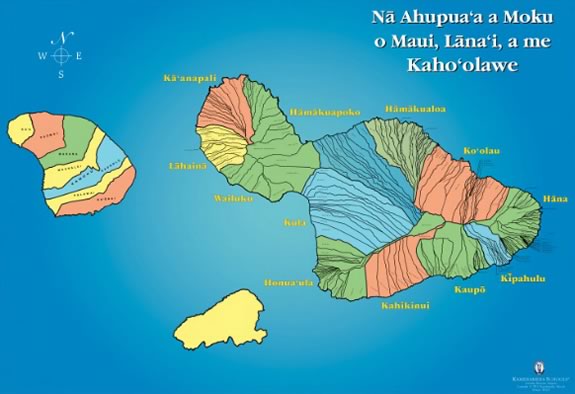
Map: Kahoʻolawe
- BIOLOGY: Calabash of the Winds
- MARINE: Kūʻula, Hina me ʻAiʻai
- VOYAGING: Moʻikeha

